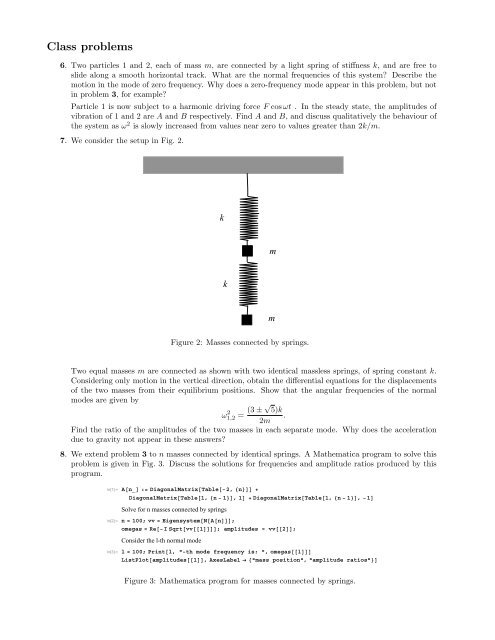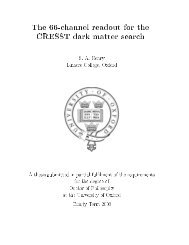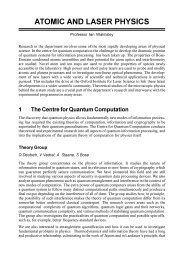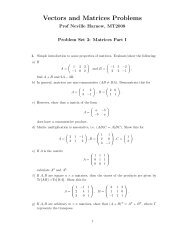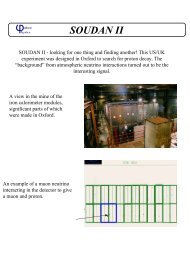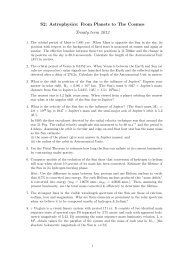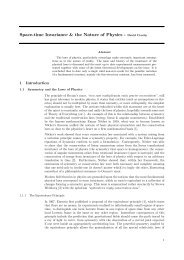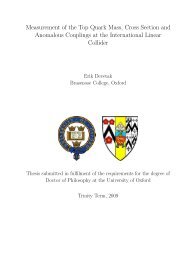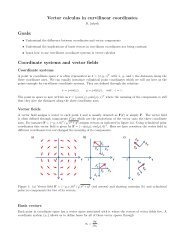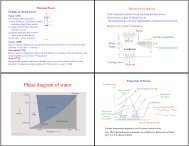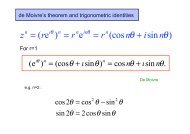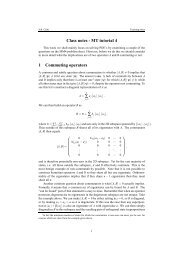Normal Modes Goals: Additional Resources: Problems:
Normal Modes Goals: Additional Resources: Problems:
Normal Modes Goals: Additional Resources: Problems:
You also want an ePaper? Increase the reach of your titles
YUMPU automatically turns print PDFs into web optimized ePapers that Google loves.
V + K = mQ! 1<br />
+ m! 1Q1 + mQ!<br />
$ % $ 2<br />
+ m!<br />
2Q2 % = E1 + E2<br />
& 2 2 ' & 2 2 '<br />
where E 1 is the total energy of ‘oscillator’ Q 1 with frequency ω 1 , and similarly<br />
for E 2 .<br />
What is the expression for the total energy when written in terms of q<br />
1<br />
, q<br />
2<br />
, q!<br />
1<br />
,<br />
and q!<br />
2<br />
? Discuss the similarities and differences.<br />
6. Two particles 1 and 2, each of mass m, are connected by a light spring of stiffness k, and are free to<br />
slide along a smooth horizontal track. What are the normal frequencies of this system? Describe the<br />
(d) Find the equations of motion for Q 1 and Q 2 from Newton’s law in the form<br />
motion in the mode of zero frequency. Why does a zero-frequency mode appear in this problem, but not<br />
V<br />
in problem 3, for example? mQ !! !<br />
1<br />
= "<br />
Particle 1 is now subject to aQ<br />
, V<br />
mQ!! !<br />
= " ,<br />
!<br />
2<br />
harmonic 1 driving force F ! cos Q2<br />
ωt . In the steady state, the amplitudes of<br />
vibration and hence ofre-derive 1 and 2 are solution A and(2).<br />
B respectively. Find A and B, and discuss qualitatively the behaviour of<br />
the system as ω 2 is slowly increased from values near zero to values greater than 2k/m.<br />
7. 4.* We consider the setup in Fig. 2.<br />
Class problems<br />
k<br />
m<br />
k<br />
m<br />
Figure 2: Masses connected by springs.<br />
Two equal masses m are connected as shown with two identical massless springs, of spring constant k.<br />
Considering only motion in the vertical direction, obtain the differential equationsW2Q: for the 3 displacements<br />
of the two masses from their equilibrium positions. Show that the angular frequencies of the normal<br />
modes are given by<br />
ω1,2 2 = (3 ± √ 5)k<br />
2m .<br />
Find the ratio of the amplitudes of the two masses in each separate mode. Why does the acceleration<br />
due to gravity not appear in these answers?<br />
8. We extend problem 3 to n masses connected by identical springs. A Mathematica program to solve this<br />
problem is given in Fig. 3. Discuss the solutions for frequencies and amplitude ratios produced by this<br />
program.<br />
In[1]:=<br />
In[2]:=<br />
In[3]:=<br />
An_ :⩵ DiagonalMatrixTable2, n <br />
DiagonalMatrixTable1, n 1, 1 DiagonalMatrixTable1, n 1, 1<br />
Solve for n masses connected by springs<br />
n ⩵ 100; vv ⩵ EigensystemNAn;<br />
omegas ⩵ ReI Sqrtvv1; amplitudes ⩵ vv2;<br />
Consider the l-th normal mode<br />
l ⩵ 100; Printl, "th mode frequency is: ", omegasl<br />
ListPlotamplitudesl, AxesLabel "mass position", "amplitude ratios"<br />
Figure 3: Mathematica program for masses connected by springs.


